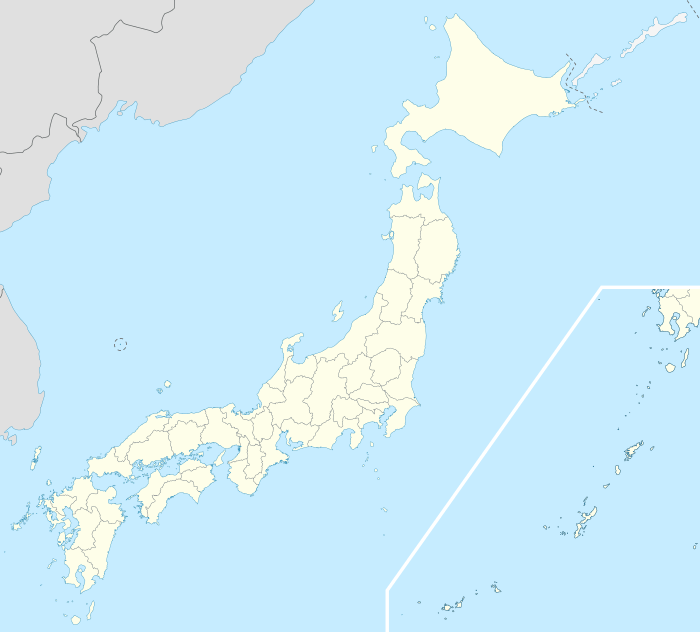Wakō, Saitama
| Wakō 和光市 | ||
|---|---|---|
| City | ||
| ||
 Location of Wakō in Saitama Prefecture | ||
 Wakō Location in Japan | ||
| Coordinates: 35°47′N 139°36′E / 35.783°N 139.600°ECoordinates: 35°47′N 139°36′E / 35.783°N 139.600°E | ||
| Country | Japan | |
| Region | Kantō | |
| Prefecture | Saitama Prefecture | |
| Government | ||
| • Mayor | Takehiro Matsumoto | |
| Area | ||
| • Total | 11.04 km2 (4.26 sq mi) | |
| Population (2008) | ||
| • Total | 76,221 | |
| • Density | 6,900/km2 (18,000/sq mi) | |
| Time zone | Japan Standard Time (UTC+9) | |
| Area code(s) | 048 | |
| Symbols | ||
| - Tree | Ginkgo | |
| - Flower | Satsuki azalea | |
| Address |
1-5 Hirosawa, Wako-shi, Saitama-ken 351-0192 | |
| Phone number | 048-464-1111 | |
| Website | City of Wakō | |
Wakō (和光市 Wakō-shi) is a city located in southern Saitama Prefecture, Japan, bordering on Tokyo.
As of May 1, 2008, the city has an estimated population of 76,221 and a population density of 6,900 persons per km². The total area is 11.04 km².
It was formerly home to a Honda factory, but is now the location for the company's technical development section. Part of the headquarters function of Honda is scheduled to move from Tokyo. The head offices of RIKEN, famous as a large natural sciences research institute in Japan, are also located in the city. Wakō has a sister city relationship with Longview, WA .
History
The city was established as Yamato Town in 1943, and was renamed Wakō on becoming a city on October 31, 1970.
Places of historical interest in the City of Wakō
Archaeological examination of several sites around Wakō has revealed the remains of a number of villages in the area. We now know that people have lived in the area since ancient times.
Excavations have revealed a large amount of Jōmon period pottery, stone tools and other remains. Signs of early rice cultivation coinciding with the Yayoi period as well as quantities of Yayoi period pottery and implements have also been found.
Myoten-ji
This temple was consecrated by Sudagoro Tokimitsu, the local administrator of Shimoniikura (1278–1287). A statue of Nichiren and a wooden plaque reside in the temple. They are important treasures of the City of Wakō. The plaque bears the inscription: "Namu myoho rengekyo" (I take my refuge in the Lotus Sutra).
Koyasu no Shimizu (Temple for Safe Childbirth)
The story goes that one day, Nichiren the founder of Nichiren sect of Buddhism, dropped in at the house of his old friend, Tokimitsu on his way to Sado. Tokimitsu's wife was going through a difficult childbirth. When Nichiren prayed for a safe delivery and made a blessing with a willow twig a spring of pure water sprang up on the spot. Nichiren then had Tokimitu's wife hold the willow twig while water from the spring was poured into her mouth whereupon she soon gave birth to a healthy baby boy.
There used to be a large willow tree beside the pond at the temple, and it is said that this tree grew from the twig that Nichiren used to bless the birth. The tree is no longer there today.
Kawagoe Road
Kawagoe Road was completed in 1633 (Kan'ei 10) when the third Shogun Tokugawa Iemitsu visited Kawagoe Senpa Toshogu (the Tokugawa family tomb). At that time, Kawagoe Castle played an important role in governing the northern part of Musashino Province and maintaining law and order in the area. Kawagoe was 10Ri (about 40 kilometres (25 mi)) from Nihonbashi in the old part of Edo and there were six juku along the way, namely: Kamiitabashi, Shimonerima, Shirako, Hizaori, Owada, and Oi. Juku were officially regulated settlements catering to travellers. Shirako juku was 20 kilometres (12 mi) from the capital of Edo and travellers often stopped there for lunch. After a steep winding hill and with ample spring water, Shirako was a good rest stop. Travellers came from the direction of Nitta Zaka then went up Oh saka and down Kurayami zaka, which was dark even in the daytime.
Choshoji (Temple of the Shingon Sect)
It is thought that this temple was built before the Edo period, however, this is uncertain. The temple was dedicated to the Juichimen Kannon (Kannon with eleven faces). The kannon is made of wood and may have been made at the beginning of the Edo period.There is a huge Ginkgo tree in the temple grounds. The tree is estimated to be over 700 years old, has a diameter of more than 7.5 meters and stands nearly 30 meters tall. It is designated as a natural monument of the City of Wako.
Ikkanji (Temple of the Soto Sect), Gorintō (five-wheeled pagoda)
Ikkanji was built during the Kan'ei era (1624–43) and was consecrated by Sakai Tadashige, a local administrator of Shimoniikura in the Edo period. It served as the family temple of the Sakai clan. Gorintō, or five-wheeled pagodas were placed at graves as a memorial and to console the spirits of the departed. Three gorinto can be found at Ikkanji at the graves of Tadashige Sakai, his wife, and a former administrator's wife.
External links
![]() Media related to Wakō, Saitama at Wikimedia Commons
Media related to Wakō, Saitama at Wikimedia Commons
- Wakō City official website (Japanese)
- Wakō City official website (English)
| |||||||||||||||||||||||||